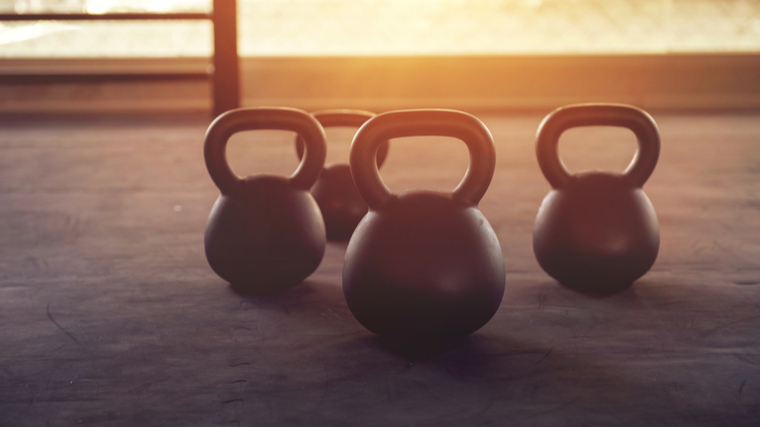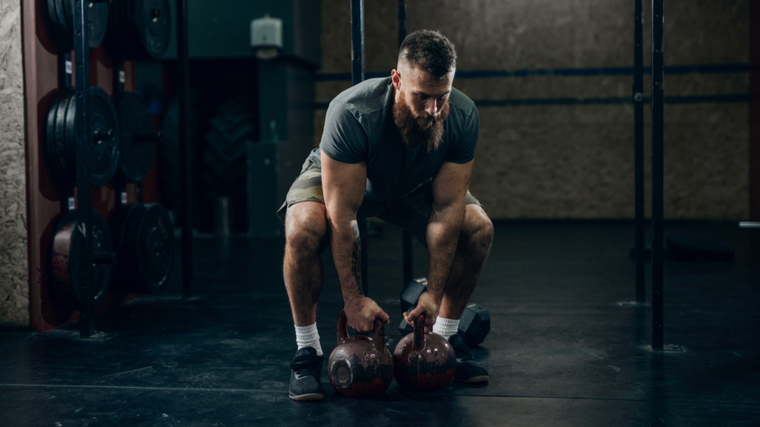If you feel like you’re hitting a bench plateau, or even if you’re seeing progress but want to add a little spice to your training, kettlebells could be your new best friend. Sure, they’re typically more associated with conditioning than strength or bodybuilding. But you can build a solid upper body with kettlebells — and that means a stronger bench press.
You can integrate any of these movements into your regularly scheduled programming as accessory work, or you can mix and match them if you really need a change of pace with your workouts.

Either way, these six moves are six more reasons why kettlebells are a game-changing training tool. You’ll also learn why kettlebells should be part of a powerlifter’s repertoire, and how to program kettlebell accessory work to supplement your powerlifts.
Best Kettlebell Exercises For The Bench Press
- Bottoms-Up Floor Press
- Alternating Floor Press
- Kettlebell Bench Press
- Alternating Stability Ball Press
- Kettlebell Skull Crusher
- Close-Grip Kettlebell Push-Up
Bottoms-Up Floor Press
This move is exactly what it sounds like. You’ll not only be performing a floor press, but you’ll also be working the hell out of your grip and stabilizers to keep the bells steady. Go light on these — it’s not about ego — but if you really feel the need to go heavier, have a buddy there as a spotter.
Benefits of the Bottoms-Up Floor Press
- Improve tricep pressing strength, which translates directly into a stronger lockout.
- Enhance comfort with safe wrist positioning during the bench press.
- Increase forearm strength and stability during pressing movements.
How To Do the Bottoms-Up Floor Press
Settle in for a regular floor press, lying on your back. Your legs can be extended or you can bend your knees and plant your feet. Hold light or moderate kettlebells in the bottoms-up position, holding the handle such that the bottom of the bell is facing the ceiling. Press up slowly, keeping your elbows tight to your body instead of flaring them out. Lower slowly until your upper arms barely kiss the ground, then press back up.
Alternating Floor Press
Alternating floor presses offer some similar benefits as one-arm dumbbell bench presses — you’ll deter strength asymmetries and refine your technique. By using a kettlebell and by alternating presses, you can increase core tension and stabilizer recruitment at the same time. You’ll also be showing some extra love to your triceps and shoulders with the reduced range of motion.
Benefits of the Alternating Floor Press
- Increase triceps strength and stability, translating into a more stable barbell bench press.
- Reduce muscle and strength asymmetries with unilateral movement and isometric holds.
- Help improve shoulder health by letting them move more freely than they can with a barbell.
How To Do the Alternating Floor Press
Set up lying on your back with your legs straight or your feet planted with bent knees. Grip the handle of the bell off to the side, with the pad where your thumb meets your index finger hugging the curve of the handle. Focus hard on keeping your wrists stable. If you need to, curve your wrists forward to counterbalance the backward pull of the weight — if done properly, there should not be any pain or excess pressure in the wrist.
Then, proceed like you would an alternating floor press with dumbbells, with one weight suspended above you while you move the other through the pressing motion. Keep the reps even on both sides.
Kettlebell Bench Press
You can really load up on this lift without worrying about your shoulders — with the bells resting comfortably on your forearms, you’ll be able to lower the weights to a much broader range of motion than you would with a barbell or dumbbells. And, since your palms are facing inward, it won’t only be your chest that’s getting a broader range of motion (building your pecs up nicely) — your triceps will also get some bonus work.
Benefits of the Kettlebell Bench Press
- Significantly increase your range of motion, improving chest muscle recruitment and hypertrophy.
- Increase attention to your triceps due to the inward-facing position of your palms.
- Move potentially very heavy loads without locking your shoulders into a pre-determined position.
How To Do the Kettlebell Bench Press
Set up just as you do with dumbbell bench presses. Make sure you’re using an offset grip for the kettlebell handle, with the pad between your thumb and index finger tucked against the curve of the handle. Keep your palms facing each other throughout the lift, almost like a neutral-grip dumbbell press.
When you’re set up with the handles at chest level, press both bells up. Pause slightly to achieve a steady position at the top, then slowly descend. Make use of the full range of motion and let the handles come all the way down to reach chest level.
Alternating Stability Ball Press
Stability balls aren’t just good for working your core. When used in place of a bench, stability balls challenge you to maintain tension throughout your entire body. In the case of alternating stability ball presses, this can translate directly into more efficient bench press mechanics.
Once you go back to the barbell, your body will be much more accustomed to maintaining impeccable form under unstable conditions. Add a kettlebell to the mix and it just keeps getting better.
Benefits of the Alternating Stability Ball Press
- Add another component of instability to your bench press training, encouraging more efficient form.
- Improve balance and pressing mechanics, along with core strength.
- Increase range of motion to increase chest muscle growth.
How To Do the Alternating Stability Ball Press
Proceed with this move in the same way you do the kettlebell bench press: same grip, same hand position (palms facing in). This time, you’ll be laying on a stability ball.
Keep your knees bent comfortably and your stance wide. Your body should be in contact with the ball across your shoulder blades. Keep your neck as neutral as you can. Find a spot on the ceiling to focus on the whole time. Press the bells one at a time, changing arms between each rep.
Kettlebell Skull Crusher
Your bench isn’t all about the chest. The triceps are a huge part of your lockout, and if you neglect them, you’re neglecting complete bench training. Training skull crushers with kettlebells will target your triceps for hypertrophy in a way that regular pressing movements — even the close grip variety — just won’t do.
Benefits of the Kettlebell Skull Crusher
- Increase tricep strength without locking your elbows into a potentially compromising position.
- Target the long head of your triceps for growth — bigger triceps can carry over into bigger lockout strength.
- Improve your upper body coordination and kinesthetic awareness in a way that can translate into improved pressing technique.
How To Do the Kettlebell Skull Crusher
Grab two kettlebells — start light — and position your hands just like you would for an EZ-bar or barbell skull crusher: wrists neutral, elbows facing the ceiling, and tucked tight into the body. Keeping the upper arms close to your body and static, bend at the elbow. Let the weights come down toward your forehead. Use your triceps to press the bells back upward until your arms are straight. Reestablish a stable position at the top and repeat.
Close-Grip Kettlebell Push-Up
Though close-grip push-ups may already be a part of your repertoire, adding a kettlebell can up the ante. Grasping the body of the bell activates the stabilizers in your forearms, wrists, and upper arms throughout the range of motion. This can translate into greater strength and stability when moving a loaded barbell. Additionally, the elevated nature of this push-up will take some pressure off of your wrists and shoulders, leaving you free to focus on building your chest.
Benefits of the Close-Grip Kettlebell Push-Up
- Increase focus on your chest muscles by giving your shoulders and wrists more positional freedom.
- Improve core muscle recruitment due to increased instability.
- Encourage more muscle activation throughout your upper and lower arms, translating into better grip and positional awareness when pressing a barbell.
How To Do the Close-Grip Kettlebell Push-Up
Lay the bell on its side, handle facing away from you, and set up for a push-up. Use a big bell to give yourself added stability. Grip the body of the bell like a medicine ball, and sink into a close-grip push-up. Go slow, focus your form, and make sure your elbows don’t flare. Pause for a brief moment at the bottom, then press back up. Rinse and repeat.
Why Should Powerlifters Use Kettlebells?
The odd shape and unstable load of the kettlebell does two amazing things for your body and your bench press. First, the instability of kettlebell lifts will challenge your stabilizer muscles in a way that just grinding it out with a barbell simply won’t do. And the better your stabilizers, the better your bench.
Second, the instability of kettlebells can actually give your joints a break. Because the bells hang more freely from your hands than barbells, they allow for unilateral moves and unique wrist positions that even dumbbells don’t easily provide. Changing something small like elbow or wrist position can make you a better overall athlete.
Programming Kettlebell Work For Powerlifters
When you’re using kettlebells for your chest accessory work, it’s important to know what your training priorities are. If you’re primarily looking to gain strength, kettlebells can help — but try not to overdo the volume.

During prep for testing your one rep max, it might be best to choose only a couple of accessory moves to maximize your recovery. In that case, try close-grip kettlebell push-ups to finish off your dynamic warm-up and improve your lockout strength. A few sets of bottoms-up floor presses after your heavy benching can help you refine your technique without overly taxing your system.
If chest hypertrophy is your main pursuit, higher volumes might serve you well. Choosing three or four of the above kettlebell chest exercises can help you get a bigger chest. Unilateral work comes with the extra perk of helping develop a balanced body on both sides.
Get Lifting
If you want an impressive bench, there’s nothing better than the lift itself. That said, smart kettlebell work for the bench press might just be the number two biggest thing you can do to get stronger.
Kettlebells are about more than developing explosive power or being functional, they can help produce slow and steady gains too. Extra range of motion and more stability work is taxing, but the benefits to your bench press will speak for themselves.
Featured Image: lunamarina / Shutterstock